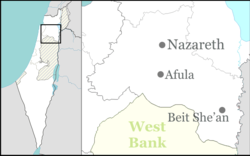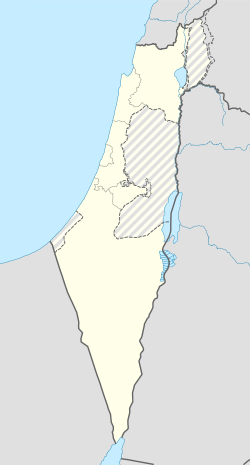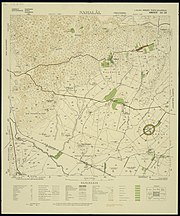
Ma'alul was a Palestinian village, with a mixed population of primarily Muslims with a substantial minority of Palestinian Christians, that was depopulated and destroyed by Israel during the 1948 Arab-Israeli war. Located six kilometers west of the city of Nazareth, many of its inhabitants became internally displaced refugees, after taking refuge in Nazareth and the neighbouring town of Yafa an-Naseriyye. Despite having never left the territory that came to form part of Israel, the majority of the villagers of Maalul, and other Palestinian villages like Andor and Al-Mujidal, were declared "absentees", allowing the confiscation of their land under the Absentees Property Law.

A moshav is a type of Israeli village or town or Jewish settlement, in particular a type of cooperative agricultural community of individual farms pioneered by the Labour Zionists between 1904 and 1914, during what is known as the second wave of aliyah. A resident or a member of a moshav can be called a "moshavnik". There is an umbrella organization, the Moshavim Movement.

Degania Alef is a kibbutz in northern Israel. The Jewish communal settlement (kvutza) was founded in 1910, making it the earliest Labor Zionist farming commune in the Land of Israel. Its status as "the mother of all kibbutzim" is sometimes contested based on a later distinction made between the smaller kvutza, applying to Degania in its beginnings, and the larger kibbutz.

Kfar Etzion is an Israeli settlement in the West Bank, organized as a religious kibbutz located in the Judean Hills between Jerusalem and Hebron in the southern West Bank, established in 1927, depopulated in 1948 and re-established in 1967. It is located 4.7 km east of the Green Line and falls under the jurisdiction of Gush Etzion Regional Council. In 2022, Kfar Etzion had a population of 1,371.

Shmuel Dayan was a Zionist activist during the British Mandate of Palestine and an Israeli politician who served in the first three Knessets.
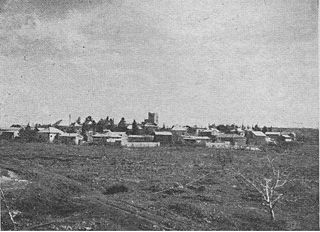
Atarot was a moshav in Mandatory Palestine, north of Jerusalem along the highway to Ramallah. It was named after the biblical Atarot mentioned in Joshua 16:2, which is believed to have been situated nearby. The moshav was captured and destroyed by the Jordanian Arab Legion during the 1948 Arab-Israeli War. Atarot Airport, closed since the Second Intifada, and Jerusalem's largest industrial park are now located there.

Beit Hillel is a moshav in northern Israel. Located on the west bank of the Hasbani River, about 5 kilometres from Kiryat Shmona, its 3,500 dunams fall under the jurisdiction of Mevo'ot HaHermon Regional Council. As of 2022, it had a population of 807.
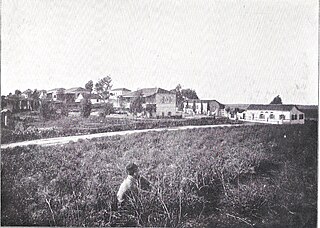
A moshava was a form of agricultural Jewish settlement in the region of Palestine, established by the members of the Old Yishuv beginning in the late 1870s and during the first two waves of Jewish Zionist immigration – the First and Second Aliyah.

Kfar Yehezkel is a moshav in northern Israel. Located in the Jezreel Valley, six kilometres southeast of Afula, it falls under the jurisdiction of Gilboa Regional Council. In 2022 the moshav had a population of 1,242.

Kfar Yehoshua is a moshav in northern Israel. Located between Haifa and Nazareth, it falls under the jurisdiction of Jezreel Valley Regional Council. In 2022 it had a population of 1,251.
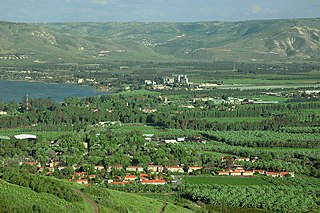
Kvutzat Kinneret, also known as Kibbutz Kinneret, is a kibbutz in northern Israel. The settlement group (kvutza) was established in 1913, and moved from the Kinneret training farm to the permanent location in 1929. Located to the southwest of the Sea of Galilee near Tiberias and next to Moshavat Kinneret, it falls under the jurisdiction of Emek HaYarden Regional Council. In 2022 it had a population of 715.

Tzur Moshe is a moshav in central Israel, in the Central district. Located in the Sharon plain near Netanya, it falls under the jurisdiction of Lev HaSharon Regional Council. In 2022 it had a population of 3,253.

Kfar Uria is a moshav in central Israel. Located near Beit Shemesh in the Shephelah. It falls under the jurisdiction of Mateh Yehuda Regional Council. In 2022 it had a population of 910.
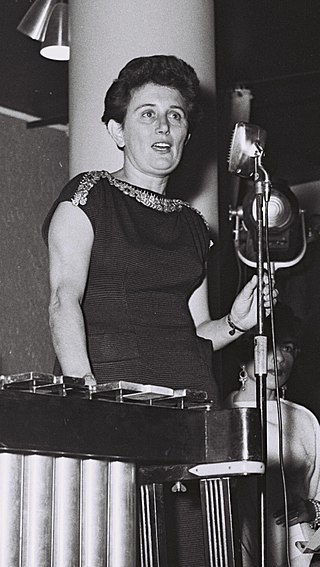
Ruth Dayan was an Israeli social activist who was the founder of the Maskit fashion house. She was also the first wife of Israeli Foreign Minister and General, Moshe Dayan (1915–1981). Active in many social causes, Dayan was a recipient of the Israeli President's Medal of Distinction, the Solomon Bublick Award, and the Yigal Allon Prize, in recognition of her social empowerment efforts.

Zvi Yehuda was a Zionist activist and later an Israeli politician.

Events in the year 1921 in the British Mandate of Palestine.
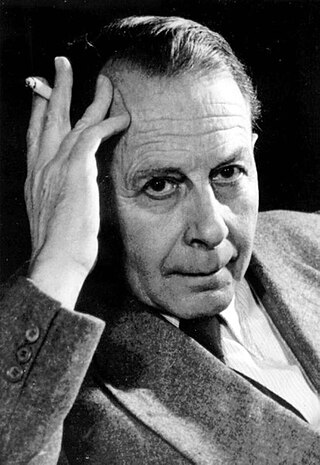
Richard Kauffmann (1887–1958) was a German-Jewish architect who migrated to Palestine in 1920. His architecture was influenced by Ludwig Mies van der Rohe, a proponent of the International Style, and was applied to the local landscape, laying the architectural groundwork for the nascent State of Israel and the White City, as Tel Aviv's International Style architecture became known.
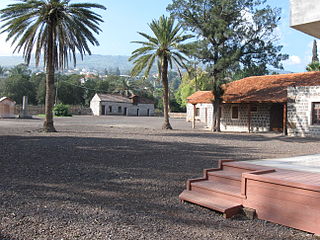
Kinneret Farm or Kinneret Courtyard was an experimental training farm established in 1908 in Ottoman Palestine by the Palestine Bureau of the Zionist Organization (ZO) led by Arthur Ruppin, at the same time as, and next to Moshavat Kinneret, a moshava-type village. The farm stood in close proximity to the shore of the Sea of Galilee. Until the early 1920s the farm was a hothouse and catalyst for social and economical innovation, which helped mold and create several essential institutions and infrastructure elements of the Yishuv, perpetuated in the State of Israel after 1948: communal settlement forms, women's rights movement, cooperative enterprises, a workers' savings and support bank, public health care system, a national paramilitary organisation. From 1949 on, after the establishment of the State of Israel, the courtyard served different lesser military and civilian purposes, was abandoned, then restored as a heritage site, and it 2007 it was opened as a museum and educational centre.

The Sursock Purchases were land purchases made by Jewish organizations from the absentee landowning Lebanese Greek Orthodox Christian Sursock family, mainly from 1901 to 1925. These included the Jezreel Valley and Haifa Bay, as well as other lands in what became the Mandate for Palestine. These collectively formed the largest Jewish land purchase in Palestine during the period of early Jewish immigration.

The remnants of the historic Moshava in Kfar Malal are buildings and items that were preserved from the Zionist Moshava established there in 1912, originally called Ein Hay. Between 1918 and 1921, the settlement's buildings were destroyed twice by the Ottomans and Arab rioters respectively. However, despite the difficulties, the settlement was rebuilt three times in total, and eventually expanded and thrived.

